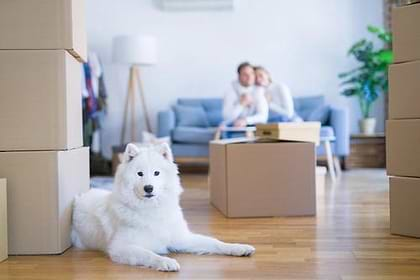
As pet parents, we like to be there for as many of our dogs’ special moments as possible. This is what allows dogs and humans to form such a close bond that has been honed over centuries of domestication. A particularly rousing game of fetch or cuddling up together at the end of a long day makes it all worthwhile.
It can’t all be fun and snuggles, though. It is our duty (get it?) as pet parents to clean up after our pets’ defecation sessions. Cleaning up our pet’s poop is not necessarily enjoyable, but it is important for everyone involved.
Whether you are out on a walk together, visiting the dog park, or just in your own yard, picking up after your dog has done their business helps everyone.
The last thing we want is to be caught unawares with no way to get rid of the evidence after our dogs go to the bathroom. Even if you are only planning a quick outing, nature can call anytime. Always be prepared with a plethora of poop bags for quick and easy cleaning.
There is one thing more unpleasant than cleaning up after our dogs’ poop, and that is when they do not poop at all, or when what they do pass is small and hard. A regular digestive system is indicative of a healthy dog, so it can be concerning to pet parents when something is amiss. In this article, we will cover what exactly qualifies as dog constipation, what can cause it, and what you can do to help.
1. What Is Considered Constipation in Dogs?
Some pet parents can get concerned when their dogs skip a poop opportunity. If your pet usually goes twice daily, it can be odd if there is a day when they only go once.
There are a number of reasons that your dog could be constipated that we will get into in a bit. However, everything should still be considered normal up until two days without a bowel movement.
If your dog holds it in for a day or so, now is the time to think about the circumstances. Has your dog shown any signs of discomfort such as straining, whining, or excessive circling and squatting especially when outside? Also, have their recent bowel movements been healthy and regular? A constipated dog can still poop, but it is likely to appear as rock-hard, small pellets.
If your dog seems comfortable, it has been a brief amount of time, and they have otherwise been regular in terms of digestion, chances are that nothing is wrong.
It is also worth noting that every dog’s digestive system will operate slightly differently. Some dogs might go once per day, while others might go twice, and others still might vary from day to day. This is yet another way that dogs keep our lives interesting and unpredictable, even if this might not be their cutest way of doing so.
Even if your dog’s schedule is not what would be considered the norm (going once or twice per day, usually), your dog might still be just fine. Talk to your vet if you have any questions, and always look for signs of discomfort in your pet.
The most important thing is to know your dog and understand what they are trying to tell you. That way, you can establish a baseline of what is normal for them. If that baseline starts to change, then you can figure out how to address the issue.
2. What Can Cause Dog Constipation?
Constipation can be indicative of a wide variety of ailments, so veterinarians created three subsections to help define them. These three factors include intraluminal, extraluminal, and intrinsic.
Intraluminal
Intraluminal factors are the most common of the three when it comes to chronic constipation in dogs. This category of signs of constipation refers to issues and blockages that originate from within the colon itself. These are some of the most common factors in a dog’s medical history that cause intraluminal constipation:
- A diet that is low in fiber
- Dehydration, or not drinking enough water
- Swallowing foreign objects that are hard to pass, such as grass
- Swallowing toys, or other non-digestible objects that require manual removal
- A lack of electrolytes
-Unintended side effects from certain medications, such as loss of appetite
Extraluminal
Next on our list of reasons for dog constipation, we have extraluminal. Contrary to intraluminal, this category is defined by issues that originate outside of the colon.
These are typically problems that are not based around the GI tract, but they cause a ripple effect that results in constipation. These concerns wind up causing constipation because they indirectly make the colon smaller, making bowel movements more difficult to pass.
Some common extraluminal factors include:
- Tumors that result in a narrowing of the colon
- An enlarged prostate gland
- Poorly healed pelvic fractures
Intrinsic
Last up on our incredibly glamorous list of underlying causes for dog constipation, we have intrinsic factors. These are similar to extraluminal issues, in that they originate from outside of the colon.
Where they differ, however, is that they can cause constipation by means other than just narrowing the colon. These issues can cause pain and undue strain that keeps a dog from going to the bathroom, or they can affect the digestive system and large intestine.
There is a wide range of dog health problems that fall into this category, such as:
- Hypothyroidism, when the thyroid creates fewer hormones than are required throughout the body.
- Impaction or other issues with the anal glands
- Old age
- A lack of exercise
- Megacolon
- Spinal cord issues
- Intestinal or digestive tract issues
- Kidney disease
- Nerve damage in the pelvis
- Central nervous system abnormalities
3. Hydration Is Key
Now that we know some of the most common causes of constipation in dogs, it is finally time to get into what you can do about it. For chronic constipation or constipation that is caused by underlying issues, the treatment plan is likely to be a bit different.
Short-term solutions are likely to be just that — short-term. If there is an underlying disorder causing constipation, any fix that does not directly address the problem is only temporary.
If your dog is otherwise healthy but is experiencing a bout of constipation, this is the time to try some relatively simple remedies. An exceedingly common cause of constipation and dry stools in dogs is dehydration.
This is because when the body does not have enough water, it will absorb excess liquid throughout the digestive process. This leaves the resulting bowel movement with little to no water, making it hard and difficult to pass.
Your dog should always have clean water available, and this is especially true in the summer. On hot days, or days when your dog gets a lot of exercise, they are going to need to rehydrate. You can help them by having plenty of water at the ready, whenever your pet wants it.
4. Offer Your Pet a Gentle Laxative or Stool Softener
If more time has passed than usual without your dog answering the call of nature, a gentle laxative might do the trick. Never give your dog laxatives meant for humans, as these are far too strong. Instead, many veterinarians suggest offering your pet some canned pumpkin or pumpkin puree.
Not only is this option high in both water and fiber, but most dogs absolutely love it. A treat that helps keep your dog regular and healthy? Sign us up!
5. Add Fiber to Your Dog’s Diet
When in doubt, adding a fiber or probiotic supplement to dog food can be an excellent way to kickstart their digestive system. These supplements work to soften bowel movements, making them easier to pass. Speaking to your veterinarian is the best way to ensure you give your dog the right type and dosage of fiber supplement.
For dogs who regularly deal with these issues, or if they are going to begin a medication that is known to cause constipation, talk to your vet about giving them more high-fiber food. This can help to deal with issues before they start, which is the best time to act.
6. Get Your Dog More Exercise
Exercise is one of the most effective constipation-busting alternatives that does not revolve around feeding your dog. When dogs get more exercise, their digestive systems are more active, causing them to be more regular. Be careful not to over-exercise your dog though, especially if they are exhibiting any signs of discomfort.
7. When To Take My Dog to the Veterinarian
If you have tried these tips but your dog is still constipated, the next natural step is to wonder when you should bring your pet to the vet. When more than two days have passed without your dog having a bowel movement, you should speak with a professional.
Also, if you see any signs of strain or discomfort when your dog is attempting to use the bathroom, you should reach out to the vet. Even if your dog is still going regularly, any discomfort is cause for alarm. It is much better to deal with these issues sooner rather than later, and your dog’s veterinarian can help you sort out the cause of the issue, as well as how to solve it.
Go, Dog, Go!
No pet parent revels in paying so much attention to their dog’s poop, but it comes with the territory. We have to look out for our dogs physically as well as mentally so that they can live their best lives.
Sources:
Dog Domestication and the Dual Dispersal of People and Dogs Into the Americas | PNAS

The Diggs Team
We believe our dogs deserve safer, better designed pet products.
You might also like
Crate training tips, stories and inspiration
View all blogsIn Your Diggs
Share your photos with #DiggsPet and tag us @DiggsPet on IG and TikTok.


